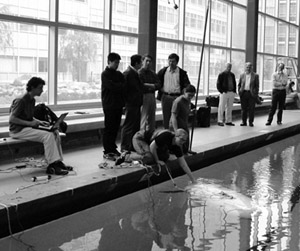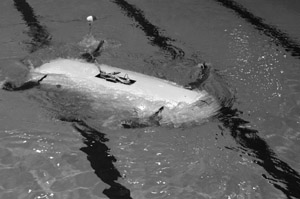Latest AUV Inspired by Sea Turtle
by Andrea Cohen, MIT Sea GrantAesop looked at animals and saw morals in the making. Michael Triantafyllou looks at them and sees a better, faster means of motion. Especially underwater. The director of MIT's Center for Ocean Engineering has been inspired by several sea creatures, designing robots that imitate fast-swimming tuna and pike. Such research, known as biomimetics, uses biological systems as models in design and engineering. Triantafyllou's most recent inspiration comes from the sea turtle and is supported by MIT Sea Grant, as well as The Office of Naval Research and DARPA/CEROS.
 Roboturtle demonstrates its prowess in the MIT swimming pool.
Roboturtle demonstrates its prowess in the MIT swimming pool.The researcher chose the turtle as a model because turtles are excellent swimmers and, unlike fish, have a hard shell. "They can position themselves very well, and they give you all this space where you can jam-pack a lot of sensors, which you don't get from the flexible hulled fish," he explains. That flexibility, coupled with robust maneuverability, bodes well for improving the performance and efficiency of autonomous underwater vehicles (AUVs), which generally have streamlined, torpedo-like shapes. State-of-the-art AUVs use propellers and are capable of traversing back and forth over areas of interest. However, they are not well-suited for controlling their position in one place for any length of time. In equipping an AUV with flapping foils akin to a turtle's fins, researchers hope to expand AUV applications in scientific, commercial, and military arenas.
The primary benefit of flapping foils, says Triantafyllou, is a greatly increased level of control. "These fins allow you to generate large transient forces very quickly, which you cannot do with propellers," he explains. That means that the Roboturtle, confronted with a strong wave or swift current, can use its fins to steady itself, making it ideal for operating in shallow waters with big waves, in swift currents, or where currents change very quickly. And for areas such as coral reefs or thermal vents, where a close inspection and fast retreat can be key.

Triantafyllou's co-principal investigator on the project is Franz Hover, principal research scientist in MIT's Dept. of Mechanical Engineering; they have been assisted by several colleagues and students. Stephen Licht, a Ph.D. candidate in MIT's Center for Ocean Engineering, worked with MITSG research engineer Victor Polidoro in designing and building the foil modules and has also been immersed in integrating the foils and sensor suites and in devising swimming strategies. Other students involved include Malima Wolf, M.S. candidate in Mechanical Engineering, and Vicente Fernandes, Ph.D. candidate in Ocean Engineering. Professor Dick Yue and principal research scientist Yuming Liu, both with Mechanical Engineering, have worked on vehicle development and are now involved in flow control issues that will improve the AUV's navigation. To better understand how turtles make swimming look so easy, Triantafyllou and colleagues watched films of various types of sea turtles in order to pick and choose the shapes and movements which, combined, would serve as the best model. However, at first glance, the AUV they've built looks less like a turtle than a yellow 6-foot-long plastic eyeglasses case with flippers. But as soon as the vehicle starts to swim, the resemblance to a sea turtle is unmistakable. In a demonstration at the MIT pool, Licht and Fernandes sit poolside with laptops connected to the vehicle's computer through an Ethernet tether. Meanwhile, Wolf and senior Lauren Cooney guide the vehicle between maneuvers. Licht, controlling the vehicle motion via his computer, says, "It's very much like a video game, where I can switch between different types of foil motions that have been preprogrammed into the vehicle, allowing me to steer [and] move in four different directions independently just by pressing arrow keys and the like."
Onboard, the vehicle has sensors to detect its acceleration and turning rates, ranging sonars that tell the researchers how far the AUV is from the pool walls and the pool bottom, and a sensor slung underneath that indicates velocity. Like a turtle, the vehicle swims backwards and forwards, up and down, maintains a stationary position and spins around. When it completes a full 360-degree barrel roll, Licht says: " [That's] something which we'd never done before." Hover adds: "It appears to have survived," and later notes that finessing control is the trickiest part of the project.
While other AUVs under development also take advantage of flapping foils, Triantafyllou notes that the Roboturtle is unique. "Our vehicle uses the flapping foils for pitching, which is like the tilting of wings, and for rolling, which is like the flapping of wings. Others are only pitching." The difference is that the rolling wings can develop very large forces fast, while the pitching wings, although faster, are for developing small forces only. The Roboturtle can do both, but its primary function is to operate in large-force environments, where other vehicles fail."
Looking ahead, Hover says, "The next step is miniaturization overall, and an expansion of the payload space." The researchers are also looking forward to quantifying the AUV's acceleration rates and abilities to move up and down - thereby allowing for comparisons with those other vehicles. Some anticipated real-world applications include using the flapping foils on ships and submarines for quick force, as well as on pleasure boats and yachts, for minimal rolling.
Triantafyllou also sees applications in another MITSG project: hunting for antiquities on the sea floor with AUVs. He journeyed last summer with MITSG's AUV Lab to Greece, for a second expedition with oceanographers and archaeologists looking for ancient shipwrecks off the island of Kythera - a major trade route in the Aegean for the past 5,000 years. Thanks to new AUV technology - which allows noninvasive surveys, inspections, and identification - "they are opening up the laws in Greece with respect to antiquities," says Triantafyllou. He explains: "In the old days, it was divers going down and [there] was strict control over what happened with the findings. But now it's in the open. The vehicle goes down; it comes up with the data."
In the meantime, closer to home, the patient testing and debugging of this latest AUV continues. Licht hopes to write his thesis "on the use of force sensors on the foils themselves to help solve the problem of how to effectively control the vehicle while swimming in an unknown flow environment." And he also notes that it's been "difficult to predict how long any given part of the project is going to take." Echoes of Aesop's diligent, plodding ‚ and winning ‚ tortoise.
